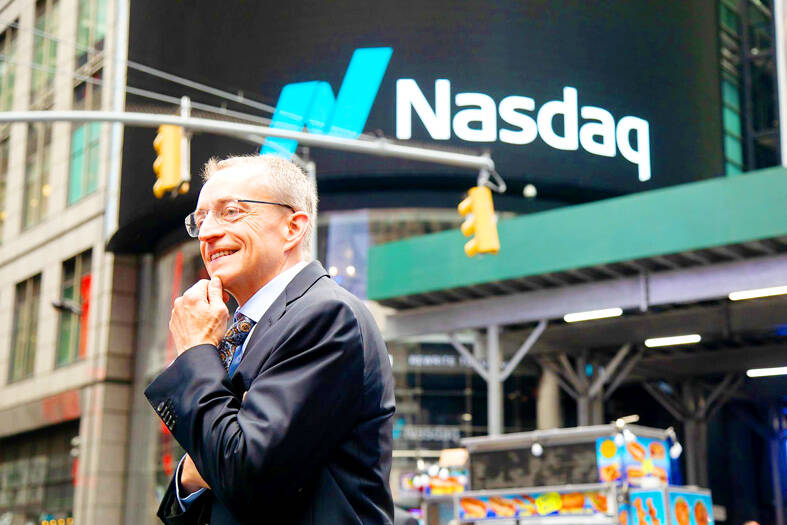Intel Corp is hitting all the targets it has set on a path to regain leadership in semiconductor manufacturing, an executive responsible for the effort said on Monday.
“We’re completely on track,” Intel vice president Ann Kelleher, the head of technology development, told a news briefing in San Francisco. “We do quarterly milestones, and according to those milestones we’re ahead or on track.”
Intel CEO Pat Gelsinger has vowed to regain leadership in production technology, formerly one of the foundations of the company’s decades of dominance in the US$580 billion industry.

Photo: Bloomberg
Kelleher’s team is trying to make up for the chipmaker’s delay in delivering a manufacturing technique that arrived five years later than originally promised.
The group is accelerating the effort to introduce new processes at an unprecedented pace.
If Gelsinger’s plan succeeds, Intel stands to reverse market share losses to rivals such as Advanced Micro Devices Inc and Nvidia Corp. Better production would also allow Intel to attract customers for the CEO’s attempt to take on Taiwan Semiconductor Manufacturing Co (台積電) and Samsung Electronics Co in the growing business of contract manufacturing.
Kelleher said Intel is taking a far more pragmatic approach than in the past, building in contingency plans to make sure there are no more major delays.
The company is also relying more on equipment vendors for help, rather than trying to do all of the work itself, she said.
“Intel in the past had high walls in terms of not sharing,” said Kelleher, who has been with the Santa Clara, California-based company for more than 30 years. “We don’t need to lead in everything.”
Intel is trying to improve its manufacturing capabilities as it struggles with declining revenue and a steep drop in demand for personal computers, which generate more than half its sales.
In October, the company said actions, including headcount reductions and slower spending on new plants, would result in savings of US$3 billion next year, with annual cuts swelling to much as US$10 billion by the end of 2025.
Intel is now mass producing 7-nanometer chips. It is ready to start manufacturing 4-nanometer semiconductors and to move to 3 nanometers in the second half of next year, Kelleher said.
She added that her budget is secure and would not be affected by the company’s cost cuts.
In related news, Intel yesterday confirmed that Gelsinger is visiting today and tomorrow the company’s Taiwanese PC and server partners, including Acer Inc (宏碁), Asustek Computer Inc (華碩) and Quanta Computer Inc (廣達).
That is part of Gelsinger’s Asia tour. He is to fly next to South Korea to meet Samsung Electronics Co executive chairman Lee Jae-yong.
Additional reporting by Lisa Wang

Intel Corp chief executive officer Lip-Bu Tan (陳立武) is expected to meet with Taiwanese suppliers next month in conjunction with the opening of the Computex Taipei trade show, supply chain sources said on Monday. The visit, the first for Tan to Taiwan since assuming his new post last month, would be aimed at enhancing Intel’s ties with suppliers in Taiwan as he attempts to help turn around the struggling US chipmaker, the sources said. Tan is to hold a banquet to celebrate Intel’s 40-year presence in Taiwan before Computex opens on May 20 and invite dozens of Taiwanese suppliers to exchange views

Application-specific integrated circuit designer Faraday Technology Corp (智原) yesterday said that although revenue this quarter would decline 30 percent from last quarter, it retained its full-year forecast of revenue growth of 100 percent. The company attributed the quarterly drop to a slowdown in customers’ production of chips using Faraday’s advanced packaging technology. The company is still confident about its revenue growth this year, given its strong “design-win” — or the projects it won to help customers design their chips, Faraday president Steve Wang (王國雍) told an online earnings conference. “The design-win this year is better than we expected. We believe we will win

Chizuko Kimura has become the first female sushi chef in the world to win a Michelin star, fulfilling a promise she made to her dying husband to continue his legacy. The 54-year-old Japanese chef regained the Michelin star her late husband, Shunei Kimura, won three years ago for their Sushi Shunei restaurant in Paris. For Shunei Kimura, the star was a dream come true. However, the joy was short-lived. He died from cancer just three months later in June 2022. He was 65. The following year, the restaurant in the heart of Montmartre lost its star rating. Chizuko Kimura insisted that the new star is still down

While China’s leaders use their economic and political might to fight US President Donald Trump’s trade war “to the end,” its army of social media soldiers are embarking on a more humorous campaign online. Trump’s tariff blitz has seen Washington and Beijing impose eye-watering duties on imports from the other, fanning a standoff between the economic superpowers that has sparked global recession fears and sent markets into a tailspin. Trump says his policy is a response to years of being “ripped off” by other countries and aims to bring manufacturing to the US, forcing companies to employ US workers. However, China’s online warriors